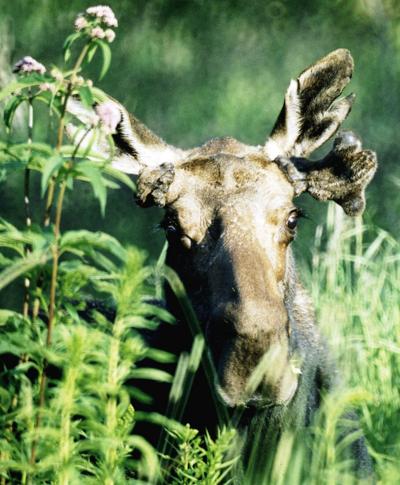Adrenaline coursed through my veins as I grabbed a camera, three lenses, a tripod, a spare camera battery, and ran out the door for what I hoped would be my first decent opportunity to photograph a bull moose in years.
“Don’t you want to change into some pants?” my wife half asked, half pleaded, as I headed toward the car in a pair of fleece pajama pants and a running jacket.
“No time,” I said, and I was gone.
A moose had been seen crisscrossing western sections of Rutland Town and Rutland City during the previous couple of days, and a friend alerted me that one had been seen just up the road from my house that morning.
I was out the door in less than a minute.
I drove slowly south, my head on a swivel as I looked from one field to the next along both sides of the road, knowing moose are capable of moving quickly, blending into the environment, and disappearing from sight in seconds.
I had driven barely a mile when I saw it — a young bull with tiny paddles for antlers, a dark coat with chestnut highlights, and a skinny frame, slowing strolling through an overgrown farm field, well off the road.
I pulled into the driveway of the farm owner, knocked on the door, and crossed my fingers; given the angle of the sun and the height of the growth in the field, the best place to see the bull was from the farmer’s backyard.
The adrenaline pumped through my veins again; I could practically see the photo I wanted in my head. I endured a failed trip to Maine and significant parts of four days spent floating in a kayak at Lefferts Pond this summer, where I repeatedly heard a male moose and a cow with a calf had been repeatedly seen.
I hadn’t seen so much as a moose track.
The owner approved my visit to his backyard, and a minute later, I was watching the little bull through a 600-mm lens with a multiplier extension. It wasn’t the shot I wanted, for a variety of reasons, but it was exciting to finally see a bull.
I’d seen just two bulls in the wild before. In 1986, I photographed the bull made famous in the book “A Moose for Jessica,” one day before he disappeared. He’d dropped one of his antlers, and I got a weird one-antlered-moose shot that’s probably somewhere in the Herald’s film archives to this day.
The only other bull I’ve ever photographed popped its head through a row of trees as my wife, some family members and I finished a hike in the Northeast Kingdom two decades ago. I shot just two frames before the moose, with deformed antlers, turned and walked away, but he was close enough that I could see his eyelashes through the viewfinder.
I was thrilled to be watching this Rutland moose as he slowly ambled through the field, picking his way from plant to plant, though I cursed the distance, undergrowth and clouds that intermittently blocked the sun and turned the moose into a dark silhouette in my lens.
I needed to give him plenty of room, as the first rules of wildlife photography are 1) keep a safe distance, and 2) don’t do anything that affects the animal’s behavior.
I also found an additional challenge: Every one of the few steps I took toward the moose was also a step downhill, which meant he became practically invisible after just a few steps, thanks to the tall undergrowth that rose up between us as I went down the hill. I moved back up the hill — and farther away — and settled in to watch.
It was a crisp, fall morning — 26° according to the gauge in my car — and as the moose breathed, his breath became a fog in the air with every exhalation.
After a few minutes, he settled in for a rest, lying deep in the undergrowth, just the top of his head visible between tufts of dead goldenrod.
Still, watching him was fascinating.
His ears were like an aerodrome, the rotating beacon airports use to help pilots locate them at night, turning aft and forward as he took in all the sounds around him.
When the 10-of-9 whistle went off in Rutland, 4 miles to the south, he briefly lifted his head and looked south, but he apparently realized it was nothing to be concerned about, and settled back for more rest.
A small flock of geese also caught his attention as they flew a couple hundred feet above, honking to one another as they passed. He again lifted his face skyward for a moment, maybe appreciating their mode of transport, or maybe just trying to determine the source of the sound.
He rested for nearly an hour, then began moving off to the east. Before he sauntered away, the sun highlighted the prominence of his ribs, leaving me with a nice memory, a couple of decent photos — and an uneasy feeling about how he might fare this winter.
Steve Costello is a former Rutland Herald and The Times Argus reporter and editor and Green Mountain Power executive, now retired and focused on wildlife photography.



